|
By Ceil Strauss, DNR, State Floodplain Manager
A surprisingly small percentage of citizens understand the rainwater that flows into storm drains ends up in our streams, rivers and lakes. Aaron Lamb, a hydrologist in the DNR's floodplain program, helped conduct a formal survey while he was a graduate student in Madison, Wisconsin. Lamb recalled, "Only about 30 percent of those surveyed realized water entering storm drains flows to water bodies."
We recently learned of a great example of stormwater education started in St. Cloud.
St. Cloud's Storm Drain Art Program
The storm drain art program within the City of St. Cloud, MN was proposed in 2020 and first implemented in 2021. The intention behind this program was to bring attention to stormwater education, stormwater stewardship, and pollution prevention. The program works with local artists and students to create designs that emphasize the importance of storm drains and their connection to clean water. There have been over nine murals completed, with additional murals planned for this year.
Examples of storm drain art in St. Cloud

Roosevelt Boys & Girls Club
Local artist Sarah Drake, herARTS in Action, worked with students from the Roosevelt Boys & Girls Club educating about water quality and where stormwater runoff goes, along with creating art.
Students brought to life the importance of picking up trash before it enters a storm drain. The octopus is holding many items that should be disposed of in the trash rather than the storm drain, or be picked-up by adopting a storm drain.
|
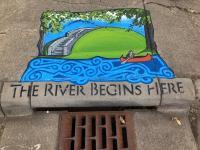
Traumen Glasberg Designs painted a mural next to Hester Park in 2022. The creation of the bridge and river emphasize that what goes down the drain will end up in the Mississippi River.
For more information about the St. Cloud program visit the Storm Drain Art Program Storymap.)
Note: The St. Cloud background and examples are adapted from the city's website.
|
Past articles on stormwater management basics:
New Elevation Forms effective as of July 7, 2023
The NEW Elevation Certificate [FEMA Form FF-206-FY-22- 152 (formerly 086-0-33)] and Dry Floodproofing Certificate [FEMA Form FF-206-FY-22-153 (formerly 086-0-34)] have been issued. The new expiration date of these forms is 06/30/2026. The FEMA website shows the Elevation Certificate was issued June 29, 2023 and the Floodproofing Certificate was issued July 6, 2023. FEMA advises the updated forms must be used for any surveys done July 7, 2023 or later.
FEMA's Elevation Certificate (EC)
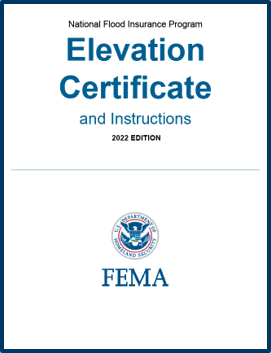
When are EC's used?
- Community Rating System (CRS) communities are required to use ECs for "as-built" surveys to document floodplain management requirements are met.
- In non-CRS communities, it is encouraged that the EC is used to document the "as-built" surveys, in addition to local forms to document state/local higher standards that are not included in the EC.
- Optional for rating flood insurance policies. While ECs are no longer mandatory for rating structures in the Special Flood Hazard Area, the more accurate elevations in ECs often support lower flood insurance premiums in all zones.
Highlights of the revisions to the EC include:
|
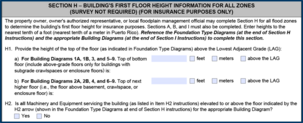
- A new Section H is available for flood insurance purposes only. This section allows measurements (versus a survey) of the building's first floor height relative to the lowest adjacent grade. The measurement can be done by anyone, including the landowner.
- Sections C and D are still only filled out by licensed surveyor or professional engineer.
- Photos must be submitted with ALL Elevation Certificates (not just when being used for flood insurance policy rating). At least four photos are generally required (with exceptions for rowhouses).
- Instructions for other sections have been revised and clarified, as needed, to ensure greater consistency and accuracy in the information provided.
|
FEMA's Dry Floodproofing Certificate for Non-Residential Buildings

When to use the form?
- Only for Dry Floodproofing of Non-Residential structures.
- When the community's floodplain management regulations allow dry floodproofing of non-residential structures.
Highlights of the revisions include:
- A revised format that requires separate certification of building design, elevation, and construction.
- A new Required Documentation page.
|
How to get the new forms
Download at FEMA website
- Go to FEMA's Underwriting forms page. Scroll down to the "NFIP Dry Floodproofing Certificate for Non-Residential Structures" or the "Elevation Certificate Form and Instructions."
-
Note: If you get a “Please Wait” error when trying to download the new Elevator Certificate form, it’s due to some incompatibility issues with the alternative PDF viewer used by certain browsers. Here’s a work around:
- Right click on the Download File link and select “save link as”
- Save it to your PC
- Once it’s on your PC, you should be able to open it.
Request from DNR Floodplain staff
If you have trouble downloading/opening the files at FEMA's site, email floodplain.dnr@state.mn.us and we can send a copy.
By Bethany Bethke, DNR, Acting Water Policy Consultant
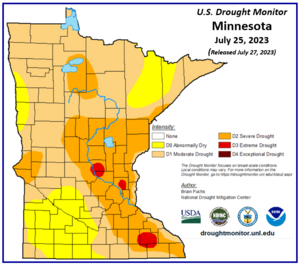
Many Minnesotans were surprised by the quick turn from abundant precipitation this spring to a dry summer. The US Drought Monitor currently classifies all of Minnesota as at least "abnormally dry." Much of the state is experiencing "moderate" or "severe drought," and there are small pockets of "extreme drought" in central and southeastern parts of the state. This drought follows the widespread and extreme drought the state experienced in 2021 and the more limited, but still consequential, drought conditions of 2022.
|
Drought actions
The Minnesota Statewide Drought Plan guides the DNR’s actions in times of drought. Conditions in the state’s 12 major watersheds drive these actions. Depending on conditions in most of each watershed, they may be in any one of the five defined phases of drought, which range from non-drought to extreme drought. As watersheds move into deeper phases of drought, the plan cues state and federal agencies, water suppliers, and users to take defined steps.
Currently, 11 of Minnesota’s 12 major watersheds are in the Drought Watch Response Phase and one watershed (St. Croix) is in the Drought Warning Response Phase. As watersheds moved into the Watch Response Phase this year, the DNR began closely monitoring conditions and increasing communications to encourage water conservation. When the St. Croix watershed reached the Warning Response Phase, the DNR notified public water suppliers in that watershed to implement conservation measures to reduce demand for water consumption.
Effects of drought seen in stream flows
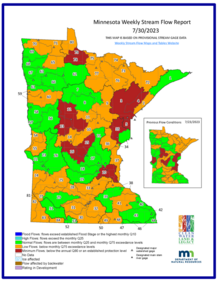
A sign of drought can be found in stream flows, which are lower than normal in many watersheds throughout the state. When stream flows reach critically low levels, the DNR may suspend surface water appropriations permits from the watershed. So far, the DNR has suspended 51 permits in two watersheds and more permits are under review.
Precipitation deficits can create an increased demand for groundwater as people seek to irrigate dry fields and lawns. The increased demand for groundwater can result in wells competing for water. Well interference can occur when high-capacity wells draw down aquifer water levels, creating an out-of-water situation in domestic wells. For more information about what to do if you suspect your well is going out of water due to increased use in an aquifer, you can visit the DNR’s well interference website.
|
More information on Minnesota drought conditions and ideas for water conservation
Drought is a normal part of Minnesota’s climate, and we expect to see some drought in part of the state in most years. Although we usually think of Minnesota as a wet place – the land of 10,000 lakes – the surface and groundwater resources we rely on for clean drinking water are not evenly distributed and can be limited. There are many ways we can make water conservation part of our daily habits, especially in times of drought. Visit the DNR’s water conservation website for ideas about how to reduce your water consumption in and around your home. You can also check with your city to make sure that you are following local water conservation ordinances.
Stay up to date on drought conditions in Minnesota by visiting the DNR’s drought website and by subscribing to our drought newsletter.
Pat Lynch, DNR Flood Hazard Mitigation Grant Assistance Program
On June 1, 2023, Governor Walz signed a record bonding bill that included $61.6 million for a host of flood risk reduction efforts around the state. Of that amount, over $46 million were earmarked for specific projects. The remaining $15 million were available to the DNR to fund projects on its list of funding priorities. Many of the projects to be funded with the 2023 appropriation are subsequent phases or continuation of flood risk reduction efforts already underway with previous funding.
Record amount, but still much work to do
The number of communities seeking financial assistance through the Flood Hazard Mitigation (FHM) Grant Assistance Program routinely exceeds funding availability. So, while the $61.6 million - plus approximately $16.2 million in match dollars from local and federal sources - will make significant progress in reducing flood risk to communities throughout Minnesota, much more work remains to further reduce impacts of flooding.
See the list of communities receiving 2023 State Flood Hazard Mitigation Grant funding.
2023 State Flood Hazard Mitigation Grants - Line Items
|
Local Government Unit/Project
|
Proposed Allocation
|
| Traverse County-Touelle Coulee Phase II |
$ 3,300,000 |
| Red River Watershed Management Board projects ($5M) |
| - City of Newfolden - Flood storage |
$ 950,000 |
| - Two River WD - Impoundment (Klondike) |
$ 250,000 |
| - Redpath - Impoundment |
$ 3,000,000 |
| - Roseau Lake Bottom -Storage |
$ 800,000 |
| City of Moorhead buyouts/capital work |
$ 11,000,000 |
| City of Carver - levee |
$ 6,000,000 |
| City of Mora - Mora high water outlet |
$ 1,800,000 |
| City of Forest Lake - flood mitigation |
$ 5,700,000 |
| City of Kasson - Flood Mitigation |
$ 5,000,000 |
| Lake Shamineau LID - lake outlet |
$ 3,000,000 |
| City of Roseau - drainage improvements |
$ 1,915,000 |
| City of Sartell -North Central Watab Watershed |
$ 2,500,000 |
| Sauk River WD - Long Lake Outlet |
$ 1,400,000 |
| Line Items Total |
$46,615,000 |
2023 State Flood Hazard Mitigation Grants - Competitive Funding (Prioritized based on $15 Million allocation)
| Local Government Unit/Project |
Proposed Allocation |
| City of Austin - WWTP mitigation |
$ 4,000,000 |
| City of Golden Valley - flood storage (at SEA School) |
$ 2,000,000 |
| City of Newfolden - Flood storage |
$ 4,500,000 |
| City of Breckenridge - Internal drainage |
$ 1,200,000 |
| Roseau River WD Lake Bottom - storage |
$ 775,000 |
| Cedar River WD small impoundments |
$ 500,000 |
| Bois de Sioux WD - Redpath - Storage |
$ 1,400,000 |
| City of Perley - Phase II Road Raise |
$ 625,000 |
| Competitive Funding Total |
$15,000,000 |
For more information
To learn more about the Flood Hazard Mitigation Grant Assistance Program, including allocation of past appropriations, please visit the FHM program web page, or contact Pat Lynch at 651-259-5691.
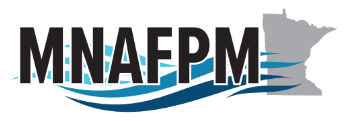
The Minnesota Association of Floodplain Managers (MNAFPM) annual conference will be held Nov. 1-3, 2023, in Moorhead.
Save the dates so you don't miss all the great presentations, workshops and opportunities to learn from each other!
- Nov. 1, 2023: Training, kickoff, and social
- Nov. 2, 2023: Main conference day
- Nov. 3, 2023: Field tour & CFM exam
See MnAFPM website for more information.
|
FEMA Region 5 staff (based in Chicago, IL) are continuing their monthly one hour virtual training series in 2023. They are FREE!
It's not too late to register for many training topics!
Upcoming "Managing your Community's Floodplain" monthly series dates and topics:

Note: All held 9-10 am Central Time.
-
Aug. 30, 2023: Reasonably Safe from Flooding: TB-10; Registration Link
-
Sept. 27, 2023: Preparedness: Substantial Damage Planning; Registration Link
These trainings and registration links are also available on DNR's Floodplain Training and Education page.
|

Talk with FEMA and DNR Floodplain program representatives during monthly virtual Minnesota Floodplain Management Office Hours. Hours are 10-11 am, typically on the fourth Thursday of the month (but a few are adjusted).
Upcoming monthly hours (Note: all are 10 - 11 am central time)
Where: Teams. No registration is required. Select a date to get the Teams meeting appointment.
These office hour dates and links are also available on DNR's Floodplain Training and Education page.
|
Important Dates to Note:
(since May 2023 Water Talk and upcoming in next couple months)
|
|
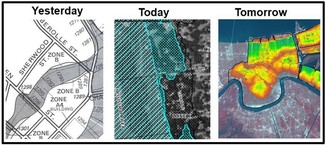 |
Preliminary Maps
- September 2023 - Olmsted (levee panel) and Wabasha Countywide
Local Officials Meetings & Open Houses
- Aug. 3, 2023 - Cottonwood County Better LOMR Flood Risk Review
- Aug. 22, 2023, 11 am-12 pm - Snake River HUC-8 Discovery Local Official Kickoff
- Aug. 23, 2023, 10-11 am - Lower Minnesota River (west) HUC-8 Discovery Local Official Kickoff
- August/September 2023 (date TBD) - Murray County Flood Risk Review
- Mid-September 2023 (date TBD) – Lake County Discovery Local Official Kickoff
- Mid-September 2023 (date TBD) – Cook County Discovery Local Official Kickoff
90-Day Appeal Periods
- Morrison County - June 4 to Sept. 2, 2023
- Stevens County (Swan Lake Township portion) - Aug 1 to Oct. 30, 2023
- Wright County (panels) - May 3 to Aug. 2, 2023
Letters of Final Determination (LFDs)
- June 7, 2023 - Watonwan Countywide
- August 2023 - Blue Earth Countywide (anticipated)
- September 2023 - Carlton and Waseca Countywides (anticipated)
Effective (6 months after LFD date)
- Sept. 7, 2023 - Lincoln Countywide
- Sept. 21, 2023 - Olmsted (Zumbro panels)
- Dec. 7, 2023 - Watonwan Countywide
Additional Map Update Information:
|